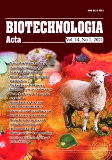ISSN 2410-7751 (Print)
ISSN 2410-776X (Online)

Biotechnologia Acta V. 14, No 1, 2021
Р. 81-87, Bibliography 17, English
Universal Decimal Classification: 579.64:633.11
https://doi.org/10.15407/biotech14.01.081
Taras Shevchenko National University of Kyiv, ESC "Institute of Biology and Medcine", Ukraine
The aim of the work was to determine the quantitative, qualitative composition and taxonomic structure of the eubacterial complex in the rhizosphere of sugar beet under different fertilizer systems.
Microbiological methods were used to determine the content of microorganisms in the rhizosphere of sugar beet. Molecular methods were used to determine taxonomic structure as well as metagenome of the eubacterial complex of microorganisms.
In the agrocenosis of sugar beet under different fertilizer systems the representatives of such families were prevailed as Alcaligenaceae, Pseudomonadaceae, Nitrososphaeraceae, Gaiellaceae, Micrococcaceae, Solirubrobacteraceae, Streptomycetaceae, Intrasporangiaceae, Solimonadaceae, Syntrophobacteraceae, Xanthomonadaceae, Enterobacteriaceae, Nocardioidaceae, Hyphomicrobiaceae, Comamonadaceae. It was found that under the biological system of fertilizers the species diversity of soil microbiota increased due to phyla: Alcaligenaceae, Gaiellaceae, Solirubrobacteraceae, Streptomycetaceae, Solimonadaceae, Syntrophobacteraceae, Xanthomonadaceae, Enterobacteriaceae, Nocardioidaceae, Hyphomicrobiaceae, Hyphomicrobiaceae.
It was detected that the basis of the eubacterial complex of sugar beet included representatives of phyla Proteobacteria, Actinobacteria, Gemmatimonadetes, Chloroflexi, Acidobacteria, Firmicutes, Planctomycetes, Verrucomicrobia, Bacteroidetes, and the absolute dominants were Proteobacteria – 76.9%, Actinobacteria – 13,4 %.
Key words: soil microbiota, fertilizer systems, metagenome, pyrosequencing, rhizosphere.
© Palladin Institute of Biochemistry of National Academy of Sciences of Ukraine, 2021
References
1. Nannipieri Р., Ascher J., Ceccherini M. Microbial diversity and soil functions. Eur. J. Soil Sci. 2003, 54 (4), 655–670, https://doi.org/10.1046/j.1351-0754.2003.0556.x
2. Rose M. T., Cavagnaro T. R., Scanlan C. A., Rose T. J., Vancov T., Kimber S., Van Zwieten L. Impact of herbicides on soil biology and function. Advances in Agronomy. 2016, V. 136, Р. 133–220. https://doi.org/10.1016/bs.agron.2015.11.005
3. Patyka M. V., Tonkha O. L., Patyka T. I., Kiroiants M. O., Veretiuk S. V. Estimation of methagen of prokaryotic chernozem complex in agricultural use. Microbiol. J. 2018, 80 (6), 109–122. https://doi.org/10.15407/microbiolj80.06.109
4. Patyka M. V., Tanchyk S. P., Kolodiazhnyi O. Yu. Formation of biodiversity and phylotypic structure of eubacterial complex of typical chernozem in winter wheat cultivation. Reports of the NAS of Ukraine. 2012, No 11, P. 163–171.
5. Patyka N. V., Patyka V. F. Agrobiology of microorganisms: diversity, structural organization and functional features. Immunology and allergology: science and practice. 2014, V. 1, P. 77–78. https://doi.org/10.15407/agrisp1.03.069
6. Demyanyuk О. S., Symochko, L. Yu., Tertychna O. V. Modern methodical approaches to evaluation the ecological condition of soil by microbial activity. Problems of Bioindications and Ecology. 2017, 22 (1), 55–68.
7. Asad M., Asad U., Lavoie M., Song H., Jin Y., Fu Z., Qian H. Interaction of chiral herbicides with soil microorganisms, algae and vascular plants. Science of the Total Environment. 2017, V. 580, P. 1287–1299. https://doi.org/10.1016/j.scitotenv.2016.12.092
8. Liu W., Marsh T., Cheng H., Forney L. Characterization of microbial diversity by determining terminal restriction fragment length polymorphisms of genes encoding 16S rRNA. Environ. Microbiol. 1997, V. 63, P. 4516–4522. https://doi.org/10.1128/AEM.63.11.4516-4522.1997
9. Imfeld G., Vuilleumier S. Measuring the effects of pesticides on bacterial communities in soil: A critical review. Eur. J. Soil Biol. 2012, V. 49, P. 22–30. https://doi.org/10.1016/j.ejsobi.2011.11.010
10. Felske A., Wolterink A., Van Lis R. Response of a soil bacterial community to grassland succession as monitored by 16S rRNA levels of the predominant ribotypes. Appl. Environ. Microbiol. 2000, V. 66, P. 3998–4003. https://doi.org/10.1128/AEM.66.9.3998-4003.2000
11. Handelsman J. Metagenomics: application of genomics to uncultured microorganisms. Microbiol. Mol. Biol. Rev. 2004, 68 (4), 669–685. https://doi.org/10.1128/MMBR.68.4.669-685.2004
12. Liuta V. A., Kononov O. V. Workshop on Microbiology: Textbook (Higher Education Institutes I-III RA). Kyiv: Medycyna. 2018, 184 p.
13. Iutynska H. O. Microbial biotechnology for the implementation of the new global program for sustainable development of the Ukrainian agrosphere. Agroecological J. 2017, No 2., P. 149–15511. https://doi.org/10.33730/2077-4893.2.2017.220171
14. Churikova V. V., Grabovich M. Ju. Morphology and cultivation of microorganisms: small workshop on microbiology. Voronezh: Voronezh State University. 2003. 55 p.
15. Kuczynski J., Stombaugh J., Anton Walters W. Using QIIME to analyze 16S rRNA gene sequences from Microbial Communities. Curr. Protoc. Bioinformatics 2012. Mode of access: https://doi.org/10.1002/0471250953.bi1007s36
16. Ronaghi M. Pyrosequencing: a tool for DNA sequencing analysis. Methods of Molecular Biology. 2004, V. 255, P. 211–219.

